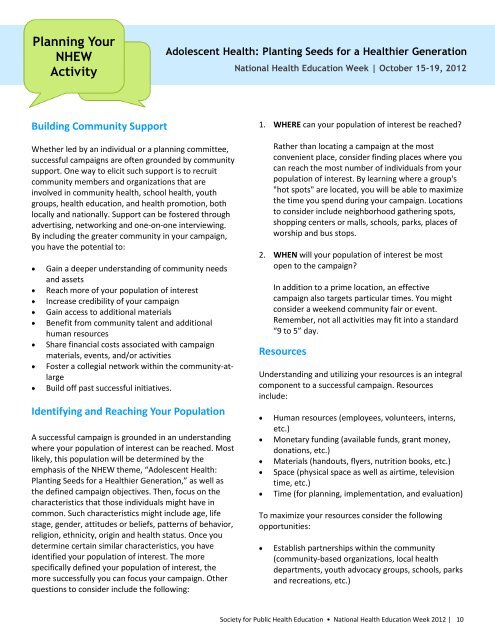Adolescent Health: Planting Seeds for a - Society for Public Health ...
Adolescent Health: Planting Seeds for a - Society for Public Health ...
Adolescent Health: Planting Seeds for a - Society for Public Health ...
You also want an ePaper? Increase the reach of your titles
YUMPU automatically turns print PDFs into web optimized ePapers that Google loves.
Planning Your<br />
NHEW<br />
Activity<br />
<strong>Adolescent</strong> <strong>Health</strong>: <strong>Planting</strong> <strong>Seeds</strong> <strong>for</strong> a <strong>Health</strong>ier Generation<br />
National <strong>Health</strong> Education Week | October 15-19, 2012<br />
Building Community Support<br />
Whether led by an individual or a planning committee,<br />
successful campaigns are often grounded by community<br />
support. One way to elicit such support is to recruit<br />
community members and organizations that are<br />
involved in community health, school health, youth<br />
groups, health education, and health promotion, both<br />
locally and nationally. Support can be fostered through<br />
advertising, networking and one-on-one interviewing.<br />
By including the greater community in your campaign,<br />
you have the potential to:<br />
Gain a deeper understanding of community needs<br />
and assets<br />
Reach more of your population of interest<br />
Increase credibility of your campaign<br />
Gain access to additional materials<br />
Benefit from community talent and additional<br />
human resources<br />
Share financial costs associated with campaign<br />
materials, events, and/or activities<br />
Foster a collegial network within the community-atlarge<br />
Build off past successful initiatives.<br />
Identifying and Reaching Your Population<br />
A successful campaign is grounded in an understanding<br />
where your population of interest can be reached. Most<br />
likely, this population will be determined by the<br />
emphasis of the NHEW theme, “<strong>Adolescent</strong> <strong>Health</strong>:<br />
<strong>Planting</strong> <strong>Seeds</strong> <strong>for</strong> a <strong>Health</strong>ier Generation,” as well as<br />
the defined campaign objectives. Then, focus on the<br />
characteristics that those individuals might have in<br />
common. Such characteristics might include age, life<br />
stage, gender, attitudes or beliefs, patterns of behavior,<br />
religion, ethnicity, origin and health status. Once you<br />
determine certain similar characteristics, you have<br />
identified your population of interest. The more<br />
specifically defined your population of interest, the<br />
more successfully you can focus your campaign. Other<br />
questions to consider include the following:<br />
1. WHERE can your population of interest be reached<br />
Rather than locating a campaign at the most<br />
convenient place, consider finding places where you<br />
can reach the most number of individuals from your<br />
population of interest. By learning where a group's<br />
"hot spots" are located, you will be able to maximize<br />
the time you spend during your campaign. Locations<br />
to consider include neighborhood gathering spots,<br />
shopping centers or malls, schools, parks, places of<br />
worship and bus stops.<br />
2. WHEN will your population of interest be most<br />
open to the campaign<br />
In addition to a prime location, an effective<br />
campaign also targets particular times. You might<br />
consider a weekend community fair or event.<br />
Remember, not all activities may fit into a standard<br />
“9 to 5” day.<br />
Resources<br />
Understanding and utilizing your resources is an integral<br />
component to a successful campaign. Resources<br />
include:<br />
Human resources (employees, volunteers, interns,<br />
etc.)<br />
Monetary funding (available funds, grant money,<br />
donations, etc.)<br />
Materials (handouts, flyers, nutrition books, etc.)<br />
Space (physical space as well as airtime, television<br />
time, etc.)<br />
Time (<strong>for</strong> planning, implementation, and evaluation)<br />
To maximize your resources consider the following<br />
opportunities:<br />
Establish partnerships within the community<br />
(community-based organizations, local health<br />
departments, youth advocacy groups, schools, parks<br />
and recreations, etc.)<br />
<strong>Society</strong> <strong>for</strong> <strong>Public</strong> <strong>Health</strong> Education • National <strong>Health</strong> Education Week 2012 | 10
















